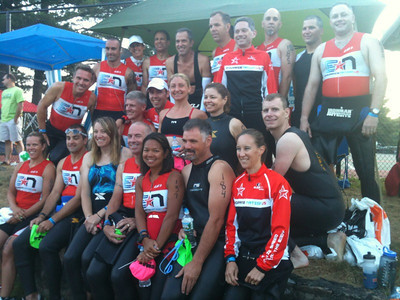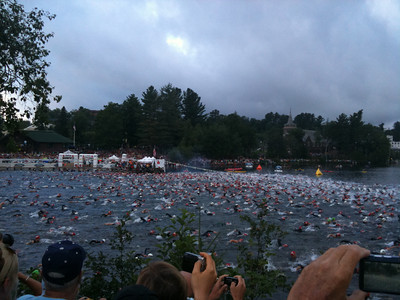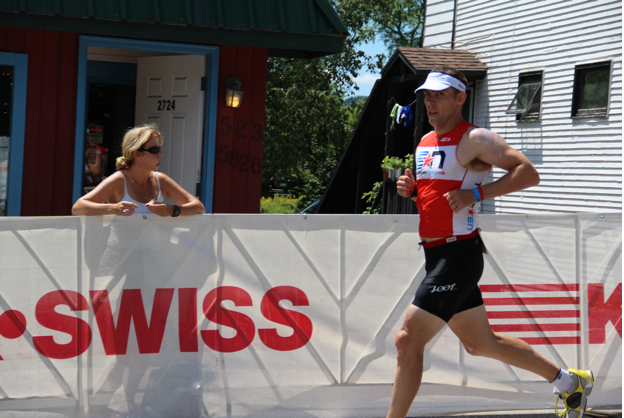 Lake Placid is one of the crown jewels of the North American Ironman® circuit. It has something for everyone, from a great course to race on to a beautiful backdrop for your friends and family to enjoy their trip as well. But it’s still an Ironman, and it’s still going to try and put the hurt on you come race day. While we have plenty of general guidance on how to race Ironman, here are three unique insider tips to help you on race day in Lake Placid.
Lake Placid is one of the crown jewels of the North American Ironman® circuit. It has something for everyone, from a great course to race on to a beautiful backdrop for your friends and family to enjoy their trip as well. But it’s still an Ironman, and it’s still going to try and put the hurt on you come race day. While we have plenty of general guidance on how to race Ironman, here are three unique insider tips to help you on race day in Lake Placid.
Access Our Insider Triathlete Email Series
#1 – The Swim – Focus on the Last Quarter
You’ll be swimming in Mirror Lake, aptly named for it’s tranquil surface. This will be the site of your fastest Ironman® swim, short of any course with an outright current. This is due in part to the fact that the water is so calm, but largely in part to the underwater cable that runs the length of the buoy line. Since the first person is right on course — exactly — so too is the second, the third, and everyone else behind. In fact, if you are able to swim without much of a crowd, you will be able to swim right on that line and never actually have to sight.
It’s precisely becuase the water conditions don’t change that we want you to focus on the last quarter of the swim: the final return from the buoys to the swim dock. Essentially you should be building your effort as you get warmed up and comfortable in the water. This is directly in opposition to what your body wants to do! Full of adrenaline, rock music and months of anticipation, you are ready to just crush it. But as you undoubtedly know by now, the time difference between a very smooth and efficient 100 yds and an all-out-till-you-black-out 100 is about four seconds…if you are lucky.
 The Lake Placid Swim Breakdown:
The Lake Placid Swim Breakdown:
Part 1: Start to the First Turn Buoy – You are settling into a good rhythm and finding your stroke. Use this part of your day to get into a groove that you define; don’t let the race take control!
Part 2: First Turn Buoy, One Full Lap Back to the Buoys Again – This section is all about being steady and smooth. By now you are settled into your swim zone, defined as the intersection of “how comfortable you are swimming” with “who else is swimming this fast” all around you. Continue to focus on form and technique instead of working any harder.
Part 3: Final Turn to the Finish – This is where we want 100% of your focus…not fitness! If you are going to lose any time on the swim, it will be here. By this point in your day you will most likely be wondering how it’s possible for a multimillion dollar organization to totally mess up and measure the course wrong. But not only is that wrong, it’s also not going to help you finish the swim! Continue to swim long and strong, maintaining tension on the water. Excellence here isn’t about finding another gear; it’s about finding a way to keep your speed up as your swim energy wanes and your mind begins to focus on the rest of your day.
#2 – The Bike –Exercise Restraint from Jay to Wilmington
The Lake Placid course is renown for it’s climbing. In reality most sections of climbing aren’t that difficult or technical. By that I mean you can see the road go up, you can see how long it goes up, and you can deal with it.
With more than a decade of coaching Ironman® atheltes under my belt, I know that the truly dangerous terrain changes are far more deceptive. These are the false flats, the climbs with false summits, etc. And there is one critical section on the Lake Placid course that fits this description. The section from Jay to Wilmington.
There are three distinct climbs in this section,which happen between miles 35 and 41 on the first lap (miles 91 to 97 on the second). All of them have solid build ups to the top, and very minimal time on the backside to recover on the descent. In other words, it’s very easy for you to expend a great deal of effort without getting very much in return.
 The Lake Placid Bike Breakdown:
The Lake Placid Bike Breakdown:
Instead of working too hard on this section, you’ll want to use this as an opportunity to do the following:
- Sit Up as You Climb – After the TT section out and back to Ausable Forks, these climbs will give you the chance to sit up and rest your back a bit. This will also allow you to change your hand positions and stay loose. Be sure to roll your neck and shake your arms out a bit to facilitate blood flow, etc.
- Stretch Your Legs If Necessary – Sitting up alone helps you use different muscle groups, but if required you can use the quick descents or subtle flats to shift a few gears harder and stand up. This is not an opportunity to stand and climb (we need to preserve your energy) but rather a change to loosen up your legs and back. No more than 10 pedal strokes here and Not On A Hill.
- Fuel for the Climb to Town – As the mileage suggests, you are not that far from the final section back into Lake Placid. While there are some good climbs here, a large portion of it can be ridden at a good speed if you can stay on the steady power. This requires that you are 100% focused on the terrain, but that you have the energy to do so. It’s also not easy to pick up speed on a descent while you wrestle with your nutrition.
 #3 – The Run – Conquer the Hills by Walking
#3 – The Run – Conquer the Hills by Walking
The run course of Lake Placid is far less deceptive…it’s just plain hard. You are either descending on the outbound leg, putting excess pressure on your quads, or you are climbing back into town. Yet the course can still be fast if you run it properly.
The key here is to remain as steady as possible. A steady effort yields a steady heart rate, and that heart rate will allow you to (A) continue fueling for the day and (B) increase the odds of not slowing down later on the run.
The easiest way to remain steady is to reduce the effects of the hills on your performance, and to do this we use walking as a strategy. During the walk segments you want to keep your arms up (like running) and continue moving forward at a brisk pace — keep your head in the game!
The Lake Placid Run Breakdown:
- Walk During the Hills – For most athletes, this option will allow you to continue your forward progress without ever coming close to redlining your heart rate. You simply eliminate the opportunity for making a mistake that will set you back later in the day. Get to the right of the road, run up as far as you can until you truly feel the effects of the hill on your form and then start the walk.
- Walk After the Hills – This is for those of you who are competing for a particular race time. In your case, running up the hill can put valuable time on the competition but it also helps to maintain your race day mojo. Once you get to the top, however, you’ll notice your heart rate has increased anywhere from 10 to 20 beats per minute over the average you had been maintaining. It’s critical that you get your heart rate down immediately, otherwise you risk elevating your core temperature and heart rate to a place from which it will never drop. A general recommendation is about 30 steps, but depending on the temperature, the distance to the finish, and your current mental and physical state, you might need a bit longer to get the heart rate back down.
Access Our Insider Triathlete Email Series
|
If you like this article, consider attending our 2013 Four Keys Pre Race talk on Friday 7/26/2013 @ 10am at the Palace Theater on Main Street. This talk is 100% free, but space is limited — please RSVP online here: http://fourkeyslakeplacid.splashthat.com |


Leave a Reply